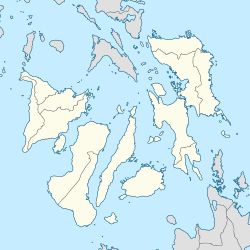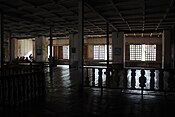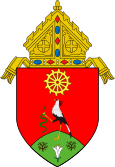Lazi Church
| Lazi Church | |
|---|---|
| San Isidro Labrador Parish Church | |
Iglesia Parroquial de San Isidro Labrador (Spanish) | |
 Lazi Church in 2019 | |
Location in the Visayas | |
| 9°07′40″N 123°38′02″E / 9.127913°N 123.633854°E | |
| Location | Lazi, Siquijor |
| Country | Philippines |
| Denomination | Roman Catholic |
| History | |
| Status | Parish church |
| Founded | 1857 |
| Dedication | Saint Isidore the Laborer |
| Architecture | |
| Functional status | Active |
| Heritage designation | National Cultural Treasure |
| Architectural type | Church building |
| Style | Neoclassical |
| Completed | 1884 |
| Administration | |
| Metropolis | Dumaguete |
| Diocese | Diocese of Dumaguete |
| Clergy | |
| Bishop(s) | Most Rev. Julito B. Cortes, D.D. |
San Isidro Labrador Parish Church, commonly known as Lazi Church, is a Roman Catholic church in the municipality of Lazi, Siquijor, Philippines within the jurisdiction of the Diocese of Dumaguete. It became an independent parish in 1857 under the advocacy of Saint Isidore the Laborer.
The church, also known for its huge convent, was declared a National Cultural Treasure by the National Museum of the Philippines. It is also nominated for the UNESCO World Heritage Tentative List since 2006 under the collective group of Baroque Churches of the Philippines (Extension) together with the churches of Boljoon, Guiuan, Loboc and Tumauini. In 2014, the government announced its plan to nominate Lazi Church in the World Heritage List. It conducted a dossier training for Lazi representatives; once the dossiers are completed, the long process of nomination will commence in Paris.
History
[edit]Lazi (formerly Tigbawan) became an independent parish from Siquijor on August 8, 1857. The present stone church was built in 1884 by Filipino artisans followed by the bell tower in the following year.[1] The construction of the convent was made with coral stones and hardwood, commenced in 1887 and completed in 1891. Both the church and the convent were done under the direction of Recollect priest Father Toribio Sánchez.[2]
Architecture
[edit]The church is built of sea stones and wood.[1] It belongs to the neoclassical style. It has two pulpits and has retained its original retablo and wood floorings.[3]
-
Church nave in 2019
Convent
[edit]The U-shaped Bahay na bato convent is one of the largest convents built during the Spanish colonial era.[1][2] On its first floor are stonewalls while wood panels can be found on the second floor.[3] Its dimension is 42 metres (138 ft) by 38 metres (125 ft).[1] It is funded by donations from parishes and missions of the Recollects.[2] Partitions of the convent were removed but the original structure was maintained. It now houses the Siquijor Heritage Museum which has collections of important church relics and paraphernalia.[4]
- Lazi Convent
-
Convent exterior
-
Convent exterior, after repair September 2019
-
Convent interior
Historical and cultural declarations
[edit]
Lazi Church was declared a National Cultural Treasure by the National Museum of the Philippines in 2001.[5] It was also declared a National Historical Landmark by the National Historical Commission of the Philippines in 1984.[6] It is also nominated to be part of the UNESCO World Heritage Sites of the Philippines under the Baroque Churches of the Philippines (Extension) with the churches of Patrocinio de María in Boljoon, Cebu; La Inmaculada Concepción in Guiuan, Eastern Samar; San Pedro Ápostol in Loboc, Bohol and San Mattias in Tumauini, Isabela.[3]
Notes
[edit]- ^ a b c d National Historical Institute 1993, p. 20
- ^ a b c "Siquijor". Panublion: Heritage Sites of the Visayan Islands in the Philippines. Archived from the original on February 11, 2006. Retrieved January 2, 2015.
- ^ a b c "Baroque Churches of the Philippines (Extension)". UNESCO World Heritage Centre. Retrieved October 9, 2014.
- ^ Calibo, Rizalie; Abatayo, Inacher (November 29, 2011). "Lazi church, convent restoration underway". Philippine Information Agency. Retrieved January 4, 2015.
- ^ Partlow, Judy Flores (July 1, 2014). "Lazi Church to be included in UNESCO's Heritage List". The Freeman. Retrieved January 4, 2015.
- ^ "Simbahan ng Lazi". National Registry of Historic Sites and Structures in the Philippines. National Historical Commission of the Philippines. Retrieved January 4, 2015.
Bibliography
[edit]- Historical Markers: Regions V-XII (in Filipino). Manila: National Historical Institute (Philippines). 1993. p. 88. ISBN 9715380697.
External links
[edit] Media related to Lazi Church at Wikimedia Commons
Media related to Lazi Church at Wikimedia Commons- Lazi Church on Facebook
- San Isidro Labrador Parish Youth Council on Facebook
- National Cultural Treasures of the Philippines
- Roman Catholic churches in Siquijor
- National Historical Landmarks of the Philippines
- Baroque church buildings in the Philippines
- World Heritage Tentative List for the Philippines
- 1857 establishments in the Spanish Empire
- Churches in the Roman Catholic Diocese of Dumaguete








